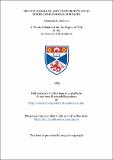Files in this item
Motion parallax and the perception of three-dimensional surfaces
Item metadata
| dc.contributor.advisor | Rogers, David J. | |
| dc.contributor.author | Graham, Maureen E. | |
| dc.coverage.spatial | 245 p. | en_US |
| dc.date.accessioned | 2018-06-26T08:55:10Z | |
| dc.date.available | 2018-06-26T08:55:10Z | |
| dc.date.issued | 1983 | |
| dc.identifier.uri | https://hdl.handle.net/10023/14579 | |
| dc.description.abstract | This thesis presents an empirical analysis of the depth cue of motion parallax. The history of research in this area is described and some recent computational models are outlined which show that parallax information can theoretically provide accurate information about the depth structure of the environment. In contrast to previous empirical work, which failed to demonstrate that motion parallax could be used effectively, the experiments reported in this thesis show that it can be an accurate source of information about depth structure. The characteristics of the processing underlying the use of motion parallax were investigated. Sensitivity to depth surfaces specified by relative motion was high, and it varied as a function of the spatial rate of change of depth. Moreover, the sensitivity function was similar to that measured for stereoscopic depth surfaces. The finding of close similarities between motion parallax and stereoscopic depth was a major theme of the thesis. Strong negative aftereffects followed prolonged viewing of depth surfaces specified by either cue and, in addition, large simultaneous contrast effects were also found. Here, the perceived depth of one area was affected by the depth of the surrounding area. These findings suggest that depth processing from both parallax and stereopsis involves extensive spatial interactions. A model of depth processing was suggested where the basic mechanisms had extended receptive fields which extracted changes in depth, specified either by relative motion or disparity, across local areas. The presence of anisotropies in the perception of depth surfaces showed that there was a differential sensitivity to particular local patterns of relative motion or disparity, which might be due to an asymmetric organisation within depth receptive fields. Finally, the motion parallax and stereoscopic depth processing systems were found to interact, indicating that information from the two sources might come together at some stage. Overall, the empirical findings emphasised the importance of extracting information about the local structure of depth surfaces rather than the depths of individual points. | en_US |
| dc.language.iso | en | en_US |
| dc.publisher | University of St Andrews | |
| dc.subject.lcc | QP493.G8 | |
| dc.subject.lcsh | Movement | en |
| dc.title | Motion parallax and the perception of three-dimensional surfaces | en_US |
| dc.type | Thesis | en_US |
| dc.contributor.sponsor | University of St Andrews | en_US |
| dc.type.qualificationlevel | Doctoral | en_US |
| dc.type.qualificationname | PhD Doctor of Philosophy | en_US |
| dc.publisher.institution | The University of St Andrews | en_US |
This item appears in the following Collection(s)
Items in the St Andrews Research Repository are protected by copyright, with all rights reserved, unless otherwise indicated.

